It’s that time of year again. Coinciding with fruit tree winter pruning season, the California Rare Fruit Growers host a series of fruit wood Scion Exchanges in the San Francisco, and Monterey Bay Areas.
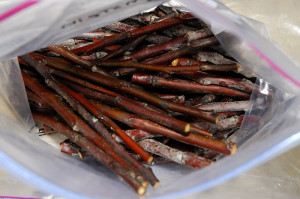
A scion, the first year growth of wood on a fruit tree, can be grafted to a new rootstock to make a new tree that is an exact clone of its parent
Last year we found scions for some wonderful varieties of fruit that aren’t locally available through area nurseries, not even by special order. For some of the more truly unique heirloom fruit varieties, scion wood grafting is a way to produce fruit trees that otherwise might be unobtainable, and an excellent way to help to conserve cultivars that have fallen out of favor in gardens and commercial orchards.
This year it’s apparent that we either need an intervention, or a larger orchard. We didn’t expect to, but over the weekend we attended, not one, but TWO Scion Exchanges, in two days!
The first exchange was held at Emma Prusch Farm Park in San José on Saturday morning, yet another wonderful jewel in the heart of the City that we hadn’t visited before. This 47 acre park was left by Emma Prusch, and was once a working dairy.
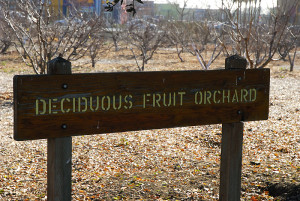
More than one orchard can be found within the park. Just behind the Deciduous Fruit Orchard, a mall. Proof this park is in the City!
The park is now home to a Heritage Orchard maintained by the CRFG, as well as an International Fruit Orchard, and High Density Demonstration Orchard, maintained by the Master Gardeners of Santa Clara County.
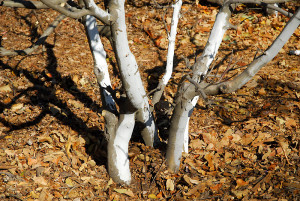
If we graft many more trees, we might have to turn our orchard into a high density orchard, where 3 or 4 trees are planted in one hole!
The park is also home to a menagerie of farm animals. It’s not every day one is greeted by a rooster in the parking lot, smack dab in the middle of a bustling city. This was just one of dozens of roosters living at the park, but our encounters with the animals will have to wait for a future post.
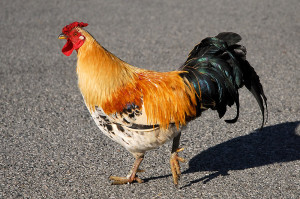
This handsome rooster greeted us in the parking lot as we got out of the car. Not a common sight in such a large city!
Back to scions though, on Sunday, we ventured back to the Monterey Chapter exchange in Aptos, to fill in a few gaps on our list of desired apple varieties. We had a lot of fun at both events, and this year, as we had a little more knowledge under our belt regarding cultivars, we were able to obtain some excellent varieties.
Some of the scions we picked up are destined to be used to help top work, and rejuvenate an old apple tree belonging to a good friend. The existing apples produced by this tree are not even remotely edible. As there is a strong root structure already in place though, rather than cut the tree down, grafting scions of other apple varieties to this existing, well established tree, will hopefully serve to transform it from a tree that is despised by its owners, to one that is enjoyed, and appreciated.
The vast majority of scions we picked up though are destined to be cleft grafted, as we did last year, to new root-stocks. We’ve picked up 20 M-111 root-stocks from the Monterey exchange, so we’ve got a LOT of grafting to do!
We had excellent results last year, and are looking forward to producing lots of new trees for planting in the orchard next winter.
Apple Scions:
Our list of apple cultivars acquired at this year’s exchanges are listed below:
Allen’s Everlasting: (Self-sterile). Russetted dessert apple. Possibly a seedling of Sturmer Pippin from Ireland, introduced in the 19th Century. Excellent sweet, crisp flavor, and an excellent keeper. We grafted this apple last year, and although the graft took, the overall vigor of this tree was lacking, so we’re trying again.
Arkansas Black: (Self-sterile) Thought to have been raised by John Crawford in Arkansas in the 1840s. Winesap believed to be one of the parents. Fruits are a very deep dark red in color, the flesh is yellow, and reportedly quite tart when harvested, but mellows in storage. This is an excellent keeping variety, and may store for up to six months in ideal conditions. Used for fresh eating, cooking, baking and cider. As with Allen’s above, we’re repeating this graft this year to see if there is any difference in vigor.
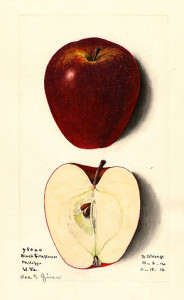
Black Gilliflower (Image Source: USDA Pomological Watercolor Collection. Rare and Special Collections, National Agricultural Library, Beltsville, MD 20705)
Black Gilliflower: (Self-sterile). This rich red skinned apple, also known as Sheepnose, originated in Connecticut in the late 18th Century. Reportedly similar to Spitzenburg in flavor, but the flesh is well suited to drying.
Bramley’s Seedling: (Self-sterile). I grew up with this apple, so I had to bring home scions. This is the quintessential English cooking apple. If you’ve eaten apple sauce, or an apple crumble in England, you’ve likely eaten Bramley’s apples. Many a blackberry and apple pie was baked in our kitchen when I was a child that contained these apples. This sharp-flavored apple is not one you’d choose to eat straight from the tree, but it’s a workhorse in the kitchen. Remarkably, the original tree still stands, planted in 1809 from seed by Mary Ann Brailsford, in Nottinghamshire, England, and is now more than 200 years old!
Claygate Pearmain: (Self-sterile) This spur-bearing apple was discovered in Claygate, Surrey, England in the 1820s. Produces heavy crops of aromatic fruit late in the season. Used for fresh eating, and a moderately good keeper. Very resistant to scab.
Cornish Gilliflower: (Self-sterile) This red and green apple was discovered in Truro, Cornwall in the early 1800s. A sweet aromatic apple, excellent for fresh eating, and a good keeper. Poor variety for use as an espalier, as this is a tip bearing cultivar.
Cox’s Orange Pippin: (Self-sterile). This orange flushed apple is considered by many to be the perfect dessert apple, and one to which all others are judged. A chance seedling discovered in the early 1800s, numerous crosses with this variety have appeared over the years, including Hauer listed below. Somewhat fussy about where it is grown, this cultivar is best suited to cooler temperate zones, and is best grown in the Pacific Northwest. This cultivar is highly susceptible to scab, and bacterial canker, but the flavor of the fruit makes it worth trying to grow here.
Cripp’s Pink: One of four pink to red-fleshed apple cultivars we acquired this weekend, Cripp’s Pink is known commercially as ‘Pink Lady’®. There is no difference between these two apples, except that those that do not meet commercial standards for sale as Pink Lady® are sold as Cripp’s Pink. Pink Lady® is purely a marketing name, not a variety of apple.
Golden Russet: (Self-Sterile). Considered one of the best heirloom “champagne” cider apples. Golden Russet dates from the mid-1800s, is a fine apple for eating and drying, and makes an excellent sweet juice. Apples are grey-green to golden bronze with a coppery orange blush. This apple is heavily splotched with light brown russet. The yellow flesh is crisp, highly flavored, with a fine-texture.
Hauer Pippin: (Self-sterile). Peter Hauer apparently discovered this chance seedling near a friend’s house in Aptos in the 1890s. Hauer Pippin is thought to be a cross between Yellow Bellflower, and a Cox’s Orange Pippin. This apple was once widely grown throughout Santa Cruz county. It is a very late ripening dessert apple, and occasionally known as ‘Christmas Apple’, as it’s one of the last varieties to ripen, toward late November. We grafted one of these last year, and the tree has been tremendously vigorous in its first year. This year we’ll graft one of these scions when we top work an existing apple tree.
Lady Williams: (Partially self-sterile). This deep-red skinned apple was discovered in Donnybrook, Australia, in 1935, and is one of the parents of Cripp’s Pink (Pink Lady®) above, and Sundowner®. This apple has the advantage of growing well in warm climates, like Southern California, where other apples may fail. This is a very-late season apple, with fruits not ripening until February in some zones, as such it is not well-suited to growing in cooler climates, and here we’ll be curious to see how it performs. This apple is good for fresh eating, and has excellent storage qualities.
Lamb Abbey Pearmain: (Self-sterile). This English dessert apple was introduced in 1804, and raised from seed from a Newport Pippin. The fruits are intensely flavored, with a good balance of sweet and tart. A good keeper, these apples ripen in the mid-season.
King David: An heirloom apple variety, reportedly originating in the 1890s as a chance seedling cross between Jonathan and either Winesap, or Arkansas Black. This apple is a good multipurpose variety, suited for eating out of hand, for cooking, juicing, and for cider-making. It is said to have flavors reminiscent of Winesap, but an appearance much closer to Arkansas Black. This variety is known for being very resistant to fire blight. Last year’s grafts were very vigorous, so we’ll see how these scions do when we top work them.
Spitzenburg: (Self-sterile) This is an excellent dual purpose apple, wonderfully flavored eaten fresh, but equally as good as a culinary apple, and also a good cider apple. Along with our Golden Russet, Yellow Bellflower, and Humboldt crab apple, we’re expecting some ‘Curbstone Valley Cider’ in the near future.
Surprise: This pink-fleshed apple is believed to have a German origin, and was brought to the Ohio River Valley in the 1840s. Pomologists speculate that its ancestor is the red-veined “Niedzwetzkyana” crab apple (see below). Surprise is a parent of Pink Pearl, although the fruits aren’t as attractive, with their dull yellow skins.
Thornberry: This is an American apple, originating in California. Like Surprise this is a pink-fleshed variety that resembles Pink Pearl in appearance, with somewhat darker flesh than Surprise. Like Pink Pearl, this apple is susceptible to scab. Fruits ripen in early October. A unique characteristic of this apple is that it bears purple to pink blooms in the spring, like the Niedzwetzkyana crab apple listed below.
Yellow Bellflower: (Self-sterile) Introduced in 1742, originating in Burlington, New Jersey, this American apple bears large yellow fruits that are excellent for cooking and cider-making, and apparently one of the best varieties for baked apples. This is an early-season apple, with good storage qualities. The flavor will mellow during storage. Reportedly one of the parents of Hauer Pippin above.
Fruiting Crab Apple Scions:
In addition to the apple varieties, we also picked up scions for my favorites, the fruiting crab apples. We had significant frustration trying to acquire fruiting crab apples locally. After discussing our dilemma with a local nursery, we were told they don’t stock them because customers no longer request them. Today it seems gardeners here only plant crab apples for their beautiful spring blooms, but prefer them to be sterile, and not set fruit. Fortunately the scion exchanges are proving to be an excellent source for such difficult to find fruits.
Chestnut: Chestnut is unusual in that it is a crab apple that is perfectly fine to eat straight from the tree, and has a somewhat nutty flavor. Most fruiting crab apples produce fruits that are better suited for the kitchen, so it will be interesting to have one crab apple variety here suited to eating out of hand.
Humboldt: This is the creation of California Pomologist Albert Etter. There’s some confusion as to its ancestry, but it is reportedly an intensely flavored crab apple variety, well suited as a culinary dessert crab.
Niedzwetzkyana: This, for me, was the most exciting find of the entire weekend. Native to Southwestern Siberia and the Caucases, this crab apple variety is thought to be the ancestor of the common pink-fleshed apples seen today, including Thornberry, Surprise, and Cripp’s Pink listed above. However, within its native range this apple is now on the IUCN list of Threatened Species. Efforts however are underway to try to identify and preserve the remaining trees within their native range. [1,2]
The skin and flesh of this crab apple is vivid red, and the tree is covered with showy purple-red blooms in the spring. The coloration is the result of anthocyanins, which also contribute red coloration in the bark and leaves of this variety as well. This trait has been passed on to some of the other pink-fleshed progeny of this apple, including Thornberry above, which also produces deep pink blooms.
Fruits ripen in October, and are reportedly somewhat dry and astringent, as is typical of many crab apples, so this is a culinary variety, and not good for eating fresh from the tree. We’re hoping these scions take to their new root-stocks, and we’re excited to see how this tree will look as it matures. I suspect it may prove to be one of the prettiest trees in our entire orchard.
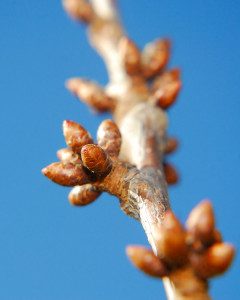
Developing buds in the deciduous orchard at Prusch Park. It's clear that spring will be here before we know it!
Wickson: Another Albert Etter variety, this is perhaps one of the most common fruiting crab apples grown in this area. Fruits are large, averaging 1.5 to 2 inches in diameter. Reportedly an excellent hard cider apple with a high sugar content, spicy flavor and a pronounced acid tang. Etter strongly recommended this variety for “champagne” cider making.
Overall we came home with many more scions than we originally intended, so we’ll have a lot of grafting to do over the coming weeks. It’s just difficult to not get excited and carried away by the tremendous variety of fruits available. We really enjoy going to these scion exchanges though, not only see the variety of fruits, but also meet a number of other like-minded individuals who are equally as passionate about growing, and conserving, heirloom fruits. If you’re considering planting an apple tree, why not choose a less common variety than one you can find in a market? Some of the best flavored fruits simply can’t be purchased, and who knows, like Mary Ann Brailsford’s tree, it might still be standing in 200 years!
————————
[1] Survey Leads to Discovery of 72 Wild Malus Niedzwetzkyana Trees in Kyrgyzstan at Global Trees
[2] Conserving a Threatened Apple in Kyrgyzstan at Global Trees

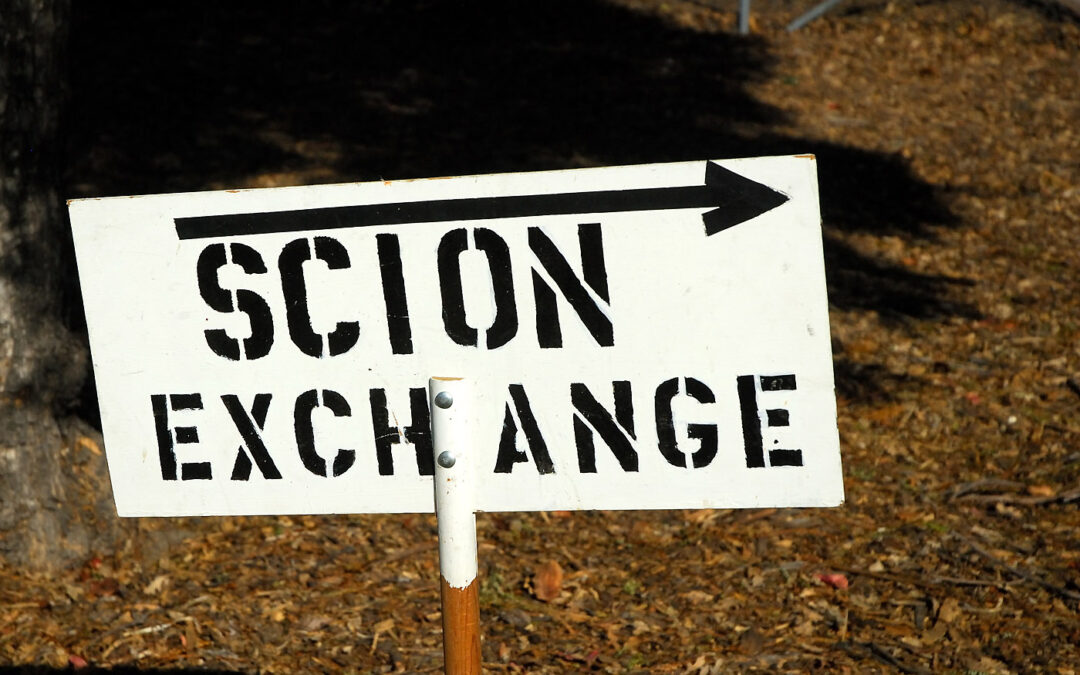
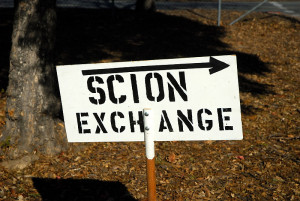
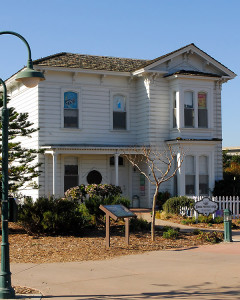
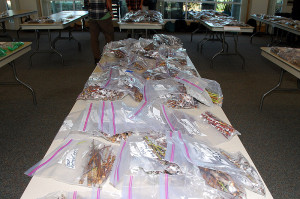

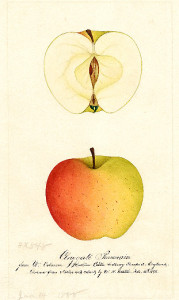
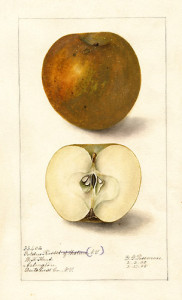
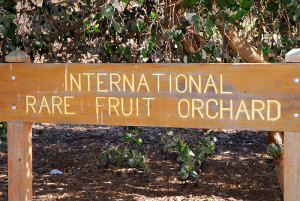
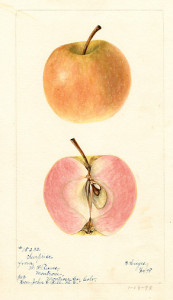
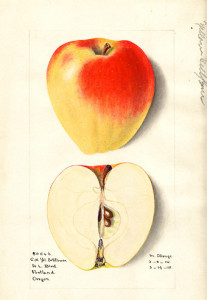







Boy I learn something every time I visit you Clare…I had no idea how this all worked…amazing how many heirloom fruits are out there to choose from…hard to choose…
We started out just planting a few fruit trees, but with so much scion wood available, we’ve realized we’d love to have a larger orchard. There really are too many to choose from!
You sure will be well stocked with apples when those all start to produce! A great idea to “fix” the tree with the inedible apples, that’s something for me to remember. The ones with the pink flesh sound fun, my little one would love those.
I love the idea of top-working an old tree, or one that doesn’t produce good fruits. The advantage is that with a strong established root system, the scions will grow more quickly once grafted. This is a method used in a number of commercial orchards. The established root stocks are considered an investment of sorts. When we top-work our friend’s tree, I promise I’ll post, as I’m sure there are a number of people staring at a tree in their yard that isn’t up to par!
This year you definitely need a larger orchard! Next year you will need the intervention. I have never heard of growing more than one tree in the same hole. Does that actually work?
High density orchard planting does work. The caveat is that it requires slightly different pruning methods, and somewhat more labor to maintain so each tree doesn’t crowd the other. It’s great for small, tight spaces though. There’s a video here of some fruit trees planted 3 or 4 to a hole. I prefer the 4ft on center approach, as I think it’s a little easier to reach each tree for pruning. Good air circulation, and plenty of sun, is a must though with any of these methods.
Clare,
What a selection of apples to add to your collection. I purchased some Arkansas Blacks at the local food coop a few weeks ago. Tasty fruit and small size the only draw back was the skin is slightly bitter. Now if you can keep up with all the names and trees that go with them.
Sometimes when I purchase heirloom fruits from a farmer’s market, I’ll buy an extra one, and set it aside for a while. There are a number of apples that, over time, actually improve in flavor, and I know Arkansas Black is one such apple. I wonder if the bitterness you detected in the skin would dissipate in a few weeks. As for keeping up on names, we have sturdy tree tags made, with the variety name, and root stock. I’d never be able to keep track otherwise! 😛
Thank you so much for this informative post – I have two apple trees that I still need to plant and this has given me lots of info to do it correctly.
I often hear people requesting apple cultivars for their orchards that are commonly available in grocery stores. I don’t think many people realize just how many different apples exist (we didn’t before we started this), and I can’t help but feel they’re missing out. As these trees can live for so long, it’s definitely worth spending a little time investigating which varieties are available and do well in your area, before digging that planting hole, Which itself isn’t always easy, as you can see here 😉
Wow! So many great apples. I plan for apples some time down the road, and you are right, I need to pick a variety that I can’t easily pick up in the market. Around here we have lots of new apples coming from Cornell University. So many apples, so much pie!
With so many to choose from, it won’t be an easy decision, but it will be fun. I just think it’s a shame to overlook excellent apples, to plant a generic commercial variety. They’re grown for their shipping qualities, not flavor, and there are some fabulously flavored heirlooms. If you have a farmer’s market, or local orchard that sells many varieties, maybe invite some friends, and do a blind apple tasting to help you pick a variety!
Interesting! I loved reading about the different apple types. When I go to the grocery story, I always try to find some new and different apple. Not always easy, but rewarding when I do. Loved seeing the rooster, too! I bet that was a fun surprise!
The roosters were quite surprising. I actually wonder if that’s where all the wayward city roosters end up. It’s a good life, they have 47 acres to run around in! Most of them were really friendly too…rather put Frodo to shame 😉
Clare, you’ve given me an interesting idea. You mention grafting onto your friends old tree and I suddenly thought of the wild apple trees that are showing up in our yard. We could potentially save some of our heritage apples by grafting scions from them onto the wild apple stock. After many years of neglect some of the trees are just too far gone. Would diseases like scab be transferred with the cutting?
That’s a really good question Marguerite. To my knowledge, if a root stock is more prone to scab than the scion, the condition is not transferred, but I’m not sure how much that has been studied. Root stocks, when selected, like our M-111 stocks, are generally chosen for height and vigor of the overall tree, and possibly for resistance to soil born organisms/nematodes. I am certain that if you graft a scion of a scab-prone cultivar to a scab resistant root stock, the cultivar will still be scab-prone. The root stock confers no resistance to the scion that’s grafted to it.
If your wild apples are healthy, and you’d otherwise risk losing your heritage apples, I’d say you have nothing to lose by trying! There’s a link to a how-to video in my response to Deb above. It’s actually a fairly straightforward procedure for top-working.
If you’d rather source root stocks that aren’t wild, I’d suggest Cummins Nursery, as they will sell small quantities of root stock, as low as $2.75. That root stock, plus your scions, makes for a pretty cheap tree, and you’d be preserving the heritage of your orchard too! 🙂
What fun to have all these varieties of apples at hand! Do you graft more than one variety onto the same rootstock (as you seem to be planning to do for your friend)? I remember my wonder at visiting a biologist/farmer friend at his home and discovering an apple tree with a dozen different varieties growing on it. One of the things I have loved about living part-time in Adams County, Pennsylvania for the past 25 years is that it’s a big apple-growing region, and when you go to a local farm market in late summer and fall, you can expect to have more than a dozen different varieties of apples to choose from. -Jean
We had some multi-graft fruit trees in our last garden, which was much smaller. Here we don’t, yet, but as we seem to keep collecting scions, and only have a limited deer-fenced area for the orchard, I expect we’ll have to start grafting more than one variety to the same tree. I think the easiest thing to do will be to add scions to some of our older trees, rather than try to graft more than one to the same root-stock, but there are methods to do that too. It’s that, or we need to move to somewhere bigger, and much flatter than Curbstone Valley 😉
How wonderful to have all the systems for plant propagation working there! It looks like most of the scions are apples, are there any more trees being exchanged? I have long wanted to do that with our mango trees which are not producing the good fruits, however here it is a bit difficult to get good scions. We have to go to the real orchards of some people to get the scions, and transport them to our farm still. It is my dream to have a mango tree with at least three varieties successfully fruiting in one tree.
Oh, there was lots of other tree scions there. Pears, Asian pears, cherries, peaches, plums etc. There was other material too, like figs (that don’t need root stocks), and quince. I didn’t look to see if there was any citrus or more tropical fruits though, but there’s usually a tremendous variety of fruits available. This year we were primarily concentrating on apples, although we did also pick up a Glout Morceau pear too. There was no pear root stock available though, so we’ll have to graft that scion to an existing tree. 🙂
Clare your taste buds will be in overload once these all fruit in a few years time. I hope you can keep the deer away from them all.